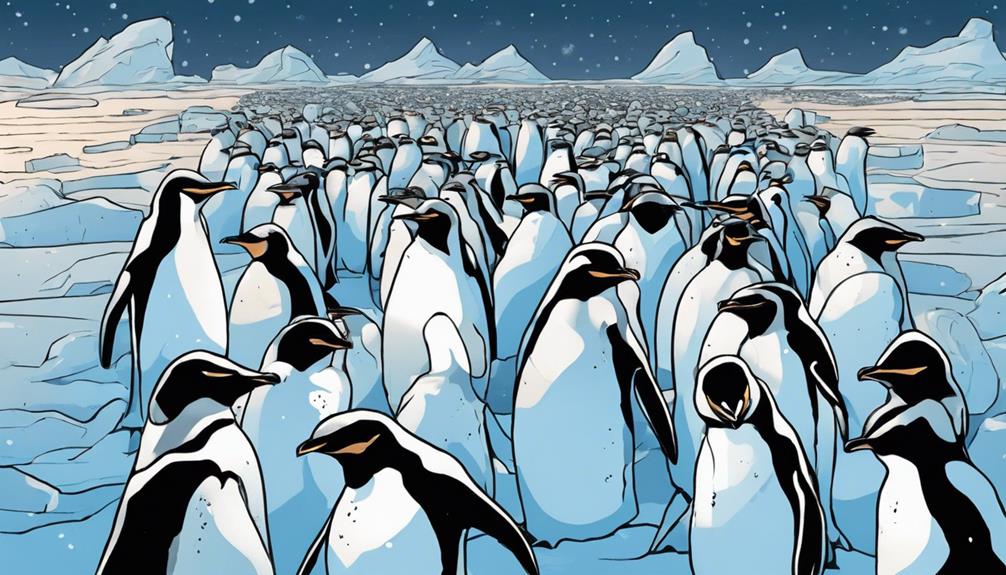You might be surprised to learn that penguins sleep standing up, with one eye open, to stay alert and conserve heat and energy. They take frequent power naps, often in groups, to recharge and reduce individual risk. Some penguins even sleep with one half of their brain while the other half remains awake, a unique adaptation called uni-hemispheric slow-wave sleep. They can even nap in the water, spending up to 75% of their day in the ocean to conserve energy and avoid predators. And that's just the tip of the iceberg – there's more to uncover about penguins' remarkable sleep habits.
Key Takeaways
- Penguins snooze on their feet to stay alert and conserve heat and energy, taking power naps throughout the day.
- Group sleeping provides safety, warmth, and shared body heat, reducing individual risk and conserving energy.
- Penguins like the Humboldt sleep with one eye open, using uni-hemispheric slow-wave sleep for vigilance and environmental awareness.
- Brief 4-second microsleeps recharge tired penguin parents, balancing parenting and foraging, while napping in water aids in energy conservation.
- Penguins have flexible sleep schedules, napping on the go, and adapting to diverse habitats with remarkable strategies for rest and survival.
Sleeping on Their Feet
When you're observing penguins on land, you might catch them snoozing on their feet, a significant trait that sets them apart from other birds. This sleep pattern is vital for their survival, as it allows them to rest while remaining alert to potential threats.
By sleeping on their feet, penguins minimize body contact with the ground, conserving heat and energy. This upright sleeping position also enables them to quickly respond to predators or other dangers.
Additionally, group sleeping is common among penguins on land, providing warmth and protection while they rest upright. This unique sleep pattern is essential for penguins, allowing them to thrive in their environment.
Power Naps Galore

As you explore the daily routine of penguins, you'll discover that they're masters of the power nap, catching frequent, short snoozes throughout the day to recharge. These brief breaks are vital for penguins to conserve energy, especially for Emperor Penguins, which take over 100 short naps daily.
You might be surprised to learn that penguins prefer to snooze in the afternoon, just like humans, albeit in shorter intervals. On average, a penguin's power nap lasts between 4 to 7.5 minutes, never exceeding 10 minutes. This unique sleep pattern allows them to rest while still being vigilant for potential predators.
Group Snoozing for Safety

While you're observing penguins in their natural habitat, you'll notice that they often sleep in groups, huddled together for warmth and protection from predators. This unique sleeping behavior is known as 'group snoozing for safety.'
By sleeping in close proximity, penguins can rely on each other's senses to stay alert for potential threats. They use their exceptional sight and hearing to remain vigilant, even while they're asleep. This is vital, as penguins are vulnerable to predators like seals and sea lions.
By sleeping in groups, they can reduce their individual risk of being attacked. This social sleeping behavior also helps to conserve energy, as they can share body heat and reduce heat loss.
As you observe these fascinating creatures, you'll realize that their group sleeping behavior is a remarkable adaptation that has evolved to safeguard their survival in harsh environments.
One Eye Open, Always

You'll be astonished to discover that some penguin species, like the Humboldt Penguin, have evolved to sleep with one eye open, ever vigilant for predators. This remarkable adaptation allows them to rest while remaining alert to potential threats.
By sleeping with one eye open, penguins can quickly respond to dangers, guaranteeing their survival in the wild. This unique technique isn't unique to penguins, as many birds and marine mammals also practice unilateral eye closure to stay safe.
When sleeping in groups, penguins rely on sight and sound cues to ensure safety and protection. Their keen senses allow them to detect even the slightest movements, enabling them to respond swiftly to potential threats.
This remarkable ability to sleep with one eye open is a proof of the remarkable adaptability of penguins, allowing them to thrive in their environments.
The Uni-Hemispheric Sleep Trick

By sleeping with one brain hemisphere in a state of deep rest, penguins have evolved a remarkable strategy to stay vigilant for predators while still getting essential rest. This unique sleep pattern, known as uni-hemispheric slow-wave sleep, allows penguins to maintain awareness of their environment, important for survival in the wild.
Here's a breakdown of how penguins adapt to their environment through their sleep strategy:
| Species | Sleep Pattern | Benefits |
|---|---|---|
| Humboldt Penguin | Uni-hemispheric slow-wave sleep | Stays vigilant for predators |
| Emperor Penguin | Uni-hemispheric slow-wave sleep | Rests while keeping one eye open |
| King Penguin | Uni-hemispheric slow-wave sleep | Balances rest with environmental awareness |
| Rockhopper Penguin | Uni-hemispheric slow-wave sleep | Maintains awareness of surroundings |
This remarkable sleep strategy showcases how penguins have adapted to balance the need for rest with the constant threats present in their habitats. By sleeping with one brain hemisphere, penguins can rest while still remaining alert to potential dangers, ensuring their survival in the wild.
Microsleeps for Tired Parents

As exhausted penguin parents juggle childcare and foraging duties, they rely on brief, 4-second microsleeps to recharge. During this time, they can quickly rest while still being vigilant for predators. In fact, research has shown that chinstrap penguins take these short microsleeps while caring for their chicks.
These microsleeps are a temporary coping mechanism for tired penguin parents, allowing them to balance their parenting and foraging duties. Although the impact of microsleep on penguins' health is still unclear, it's an essential strategy for their survival.
Here are some key points to remember about penguin microsleeps:
- Brief but effective: Microsleeps last only 4 seconds, but they're enough to help penguins recharge.
- Temporary solution: Microsleeps are a short-term strategy for managing fatigue, not a long-term solution.
- Critical for survival: Despite the uncertainty surrounding their health impact, microsleeps are crucial for penguin parents to balance their duties.
Napping in Water, No Problem

As you explore the unique sleeping habits of penguins, you'll discover that they're capable of napping in water, a feat that's essential for their survival.
In fact, they can spend up to 75% of their day in the ocean, where they float near the surface, relying on their keen senses to stay safe.
Now, let's take a closer look at how they're able to rest in the deep, sleeping while afloat.
Resting in the Deep
While swimming, you might catch a penguin snoozing in the water, and that's not a rare sight, since they spend up to 75% of their day in the ocean. As cathemeral creatures, they can be active in the water at any time, but they still need to rest. To do so, they float near the surface, staying alert while they nap. This unique ability to nap in water helps penguins conserve energy and avoid predators.
Here are three interesting facts about penguins napping in water:
- Energy conservation: Napping in water helps penguins conserve energy, which is vital for their survival.
- Predator avoidance: By resting in the water, penguins reduce their chances of being detected by predators.
- Species-specific behavior: Some penguin species, like the Emperor Penguin, regularly nap in the water, making it an important part of their daily routine.
Penguins have adapted to their aquatic environment in remarkable ways, and their ability to nap in water is just one of the many fascinating aspects of their behavior.
Sleeping While Afloat
You might be surprised to find that penguins can catch a few winks while floating near the surface of the ocean, and it's an essential part of their daily routine. This unique adaptation allows them to rest efficiently in their oceanic habitat. By using their buoyancy to float, penguins can nap in water, which helps them conserve energy during their active periods.
This remarkable ability also provides an added layer of importance, as penguins can avoid land predators while still getting some shut-eye. Even when napping in water, penguins maintain a level of awareness, allowing them to quickly respond to any threats. This is significant in their harsh environment, where predators lurk around every corner.
Napping in water is a crucial component of a penguin's daily routine, enabling them to recharge for their next foraging trip or social engagement. It's an impressive example of how these remarkable birds have evolved to thrive in their aquatic environment.
Short Sleep Cycles, Big Benefits

Chinstrap penguins caring for their chicks take brief 4-second microsleeps, a remarkable strategy that allows them to recharge without abandoning their vulnerable offspring. This unique approach enables them to get some rest while still keeping their chicks safe from predators. Despite these short sleep cycles, penguins manage to accumulate an impressive 11 hours of total sleep per day. But how do they do it?
Here are three key benefits of their short sleep cycles:
- Efficient use of time: By taking brief microsleeps, penguins can quickly recharge without sacrificing precious time that could be spent foraging for food or caring for their young.
- Increased vigilance: Short sleep cycles allow penguins to remain alert and responsive to potential threats, ensuring the safety of their chicks.
- Demonstration of resourcefulness: By trading off nesting duties and foraging at sea, penguins can provide excellent care for their young while still meeting their own energy needs.
This remarkable adaptation is a demonstration of the resourcefulness of penguins in the face of harsh environmental challenges.
Penguins' Unique Sleep Patterns

As you explore the unique sleep patterns of penguins, you'll discover that they've adapted to their environment in remarkable ways.
They've developed a strategy of sleeping in shifts, where one half of the brain is in a state of deep sleep, while the other half remains awake and alert to potential threats.
This phenomenon, known as unihemispheric slow waves, allows penguins to rest while still being vigilant and responsive to their surroundings.
Sleep in Shifts
In the harsh Antarctic landscape, penguins have evolved to sleep in shifts, trading off nest-guarding duties with foraging trips to sea, allowing them to rack up an astounding 11 hours of rest per day.
You might be wondering how they manage to get so much sleep while still taking care of their chicks and finding food. The answer lies in their unique sleep patterns.
Here are three key facts about penguin sleep habits:
- Shift sleeping: Penguins take turns sleeping while the other parent forages for food, ensuring their chicks are always protected.
- Microsleeps: Exhausted penguin parents take 4-second microsleeps while caring for their chicks, helping them cope with the demands of parenting.
- Balancing act: Penguins' sleep patterns are vital for balancing their parenting and survival tasks, allowing them to thrive in the harsh Antarctic environment.
Unihemispheric Slow Waves
You might be surprised to learn that penguins' sleep patterns get even more fascinating, with their brains capable of entering a state of uni-hemispheric slow-wave sleep. This unique ability allows one half of their brain to rest while the other half remains awake and alert.
This adaptation is essential for penguins' survival, as they need to stay vigilant for predators while still getting necessary rest. During uni-hemispheric slow-wave sleep, penguins can continue swimming or keep an eye on their surroundings for safety.
By sleeping with one hemisphere active, penguins can switch between rest and alertness seamlessly. This remarkable ability showcases their adaptation to life in both the ocean and on land. It's an impressive example of how penguins have evolved to thrive in their environment.
Adapting to Environment, Always

Every penguin species has evolved to adapt its sleep patterns to its unique environment, ensuring survival in diverse habitats. As you explore the sleep habits of penguins, you'll discover that they're incredibly adaptable creatures. Whether they're waddling on land or swimming in the ocean, penguins have developed remarkable strategies to catch some Z's.
Here are just a few examples of how penguins adapt to their environment:
- Flexible sleep schedules: Some penguins are active during the day, while others are nocturnal, depending on their habitat and the availability of food.
- Napping on the go: Penguins can take short naps while floating in the water or standing on land, always staying vigilant for predators.
- Group sleeping: Many penguin species sleep in groups, sharing body heat and protecting each other from harsh weather conditions.
Frequently Asked Questions
Do Penguins Sleep for 4 Seconds?
You're wondering if penguins sleep for 4 seconds? Well, they don't exactly sleep for 4 seconds, but they do take 4-second microsleeps while caring for their chicks, which helps them cope with exhaustion.
Do Penguins Ever Sleep?
You imagine yourself waddling alongside penguins, wondering if they ever catch some Z's. Yes, you'll be relieved to know that penguins do sleep, but in short, frequent naps, adapting to their environment and social habits.
What Does It Mean to Sleep Like a Penguin?
You're wondering what it means to sleep like a penguin? It means taking short, frequent naps throughout the day, averaging 4-7.5 minutes each, and possibly even snoozing while floating in water or standing on land!
Do Penguins Nap 1000 Times a Day?
You might've heard that penguins nap 1000 times a day, but that's likely an exaggeration. In reality, they take many short naps, over 100 a day, to conserve energy and stay alert, adding up to a significant rest period.
Conclusion
As you've explored the fascinating world of penguin sleep patterns, you might be wondering: what's the secret to their ability to catch those elusive winks in such harsh environments?
The answer lies in their remarkable adaptability, which allows them to thrive in the most inhospitable of lands. With their unique sleep tricks, penguins can snooze while standing, take power naps, and even doze off in the water.
It's no wonder they're always ready to take on the Antarctic challenges that come their way.










